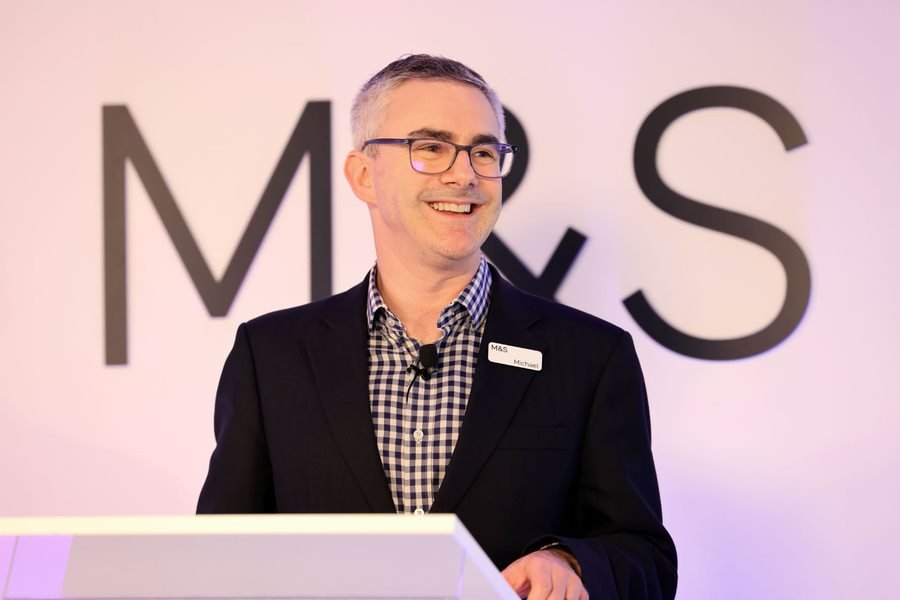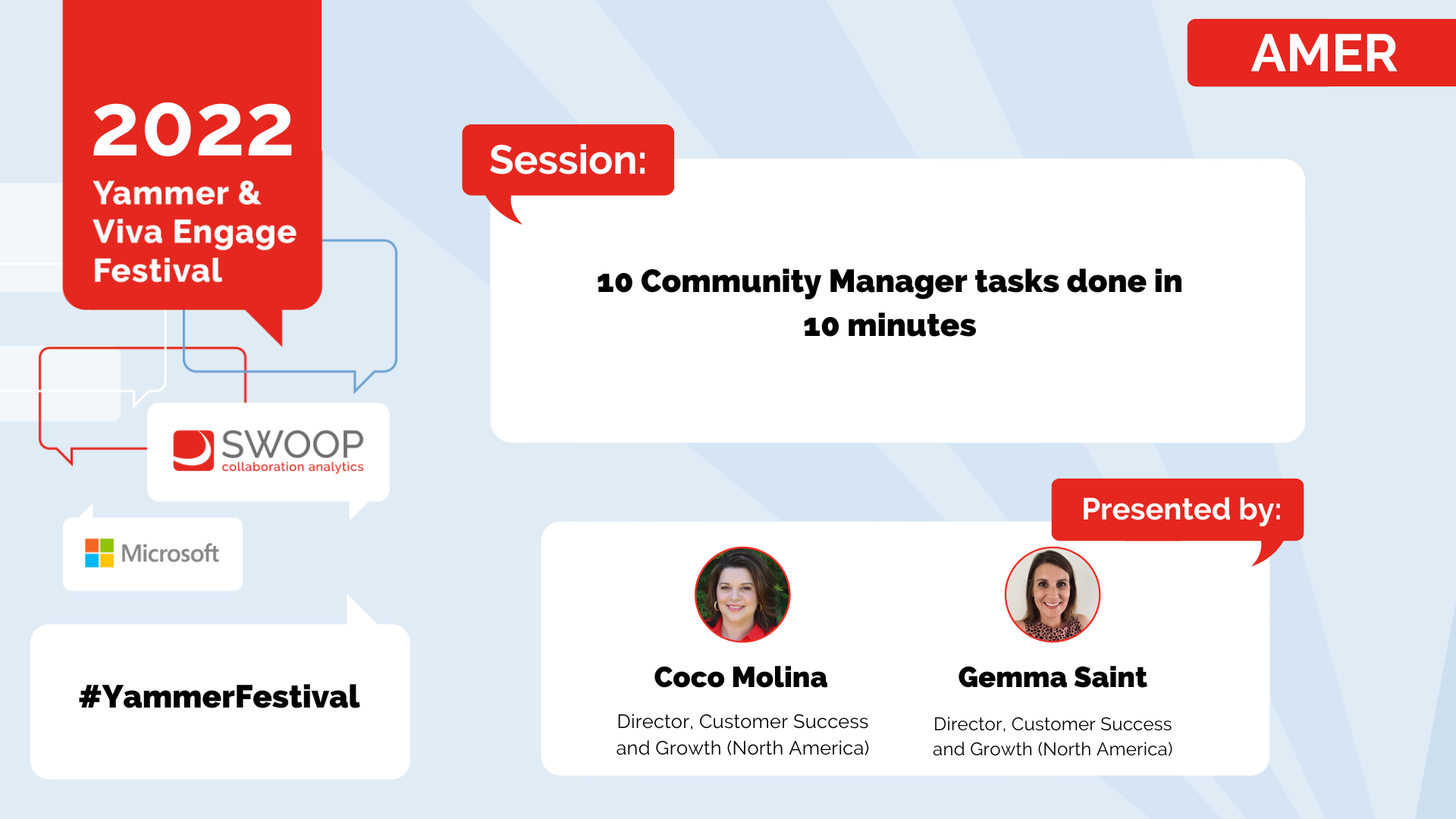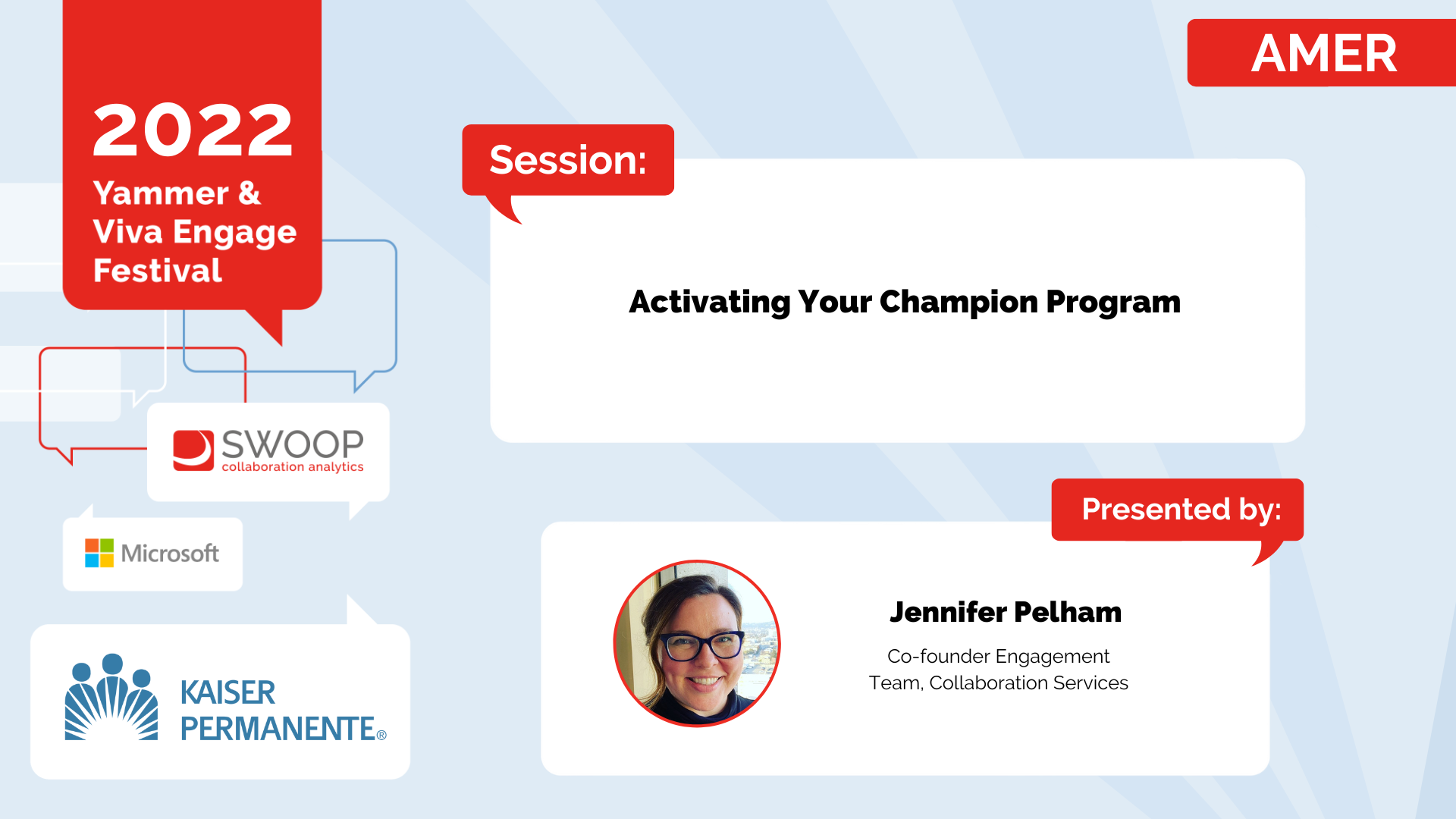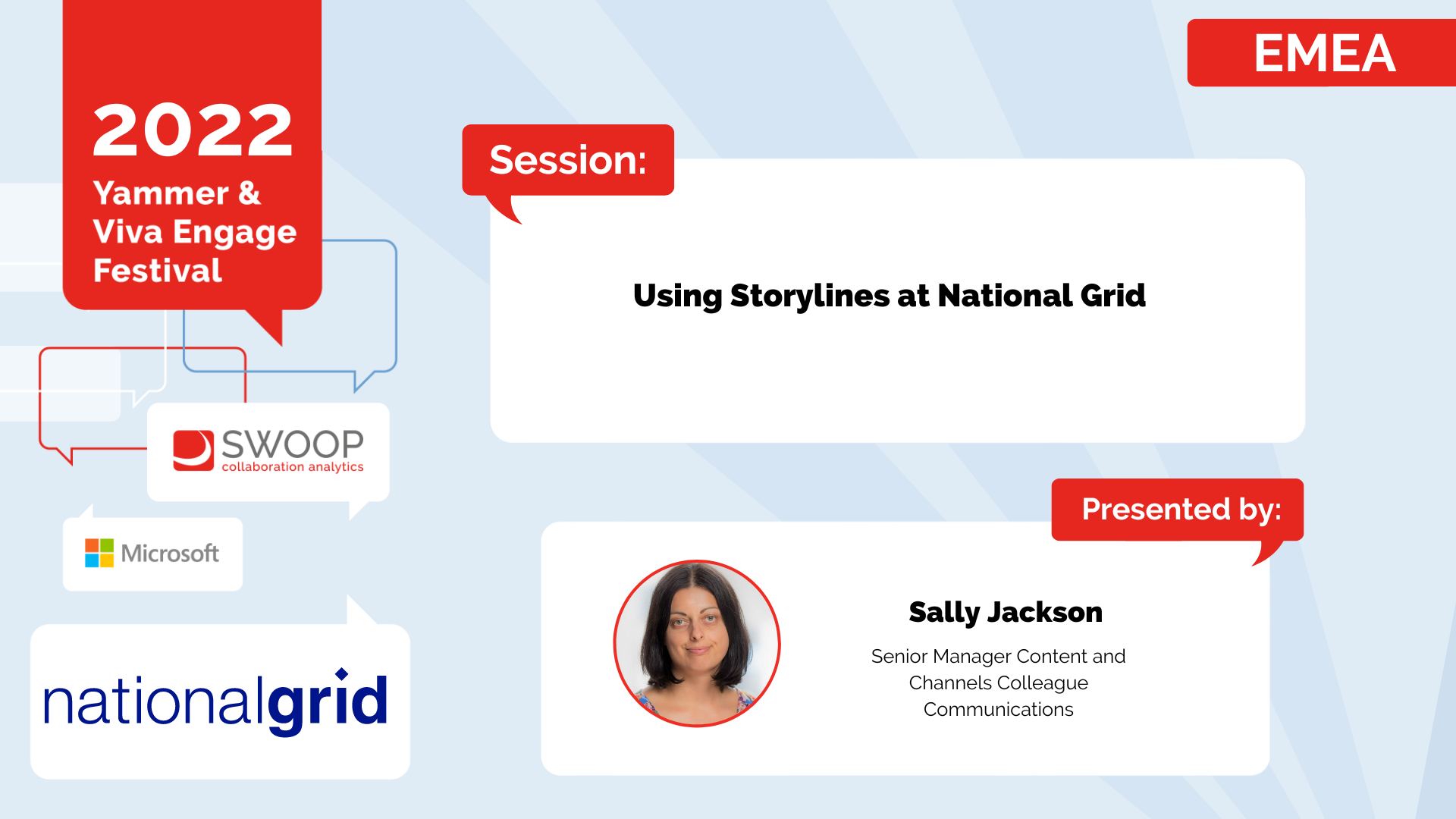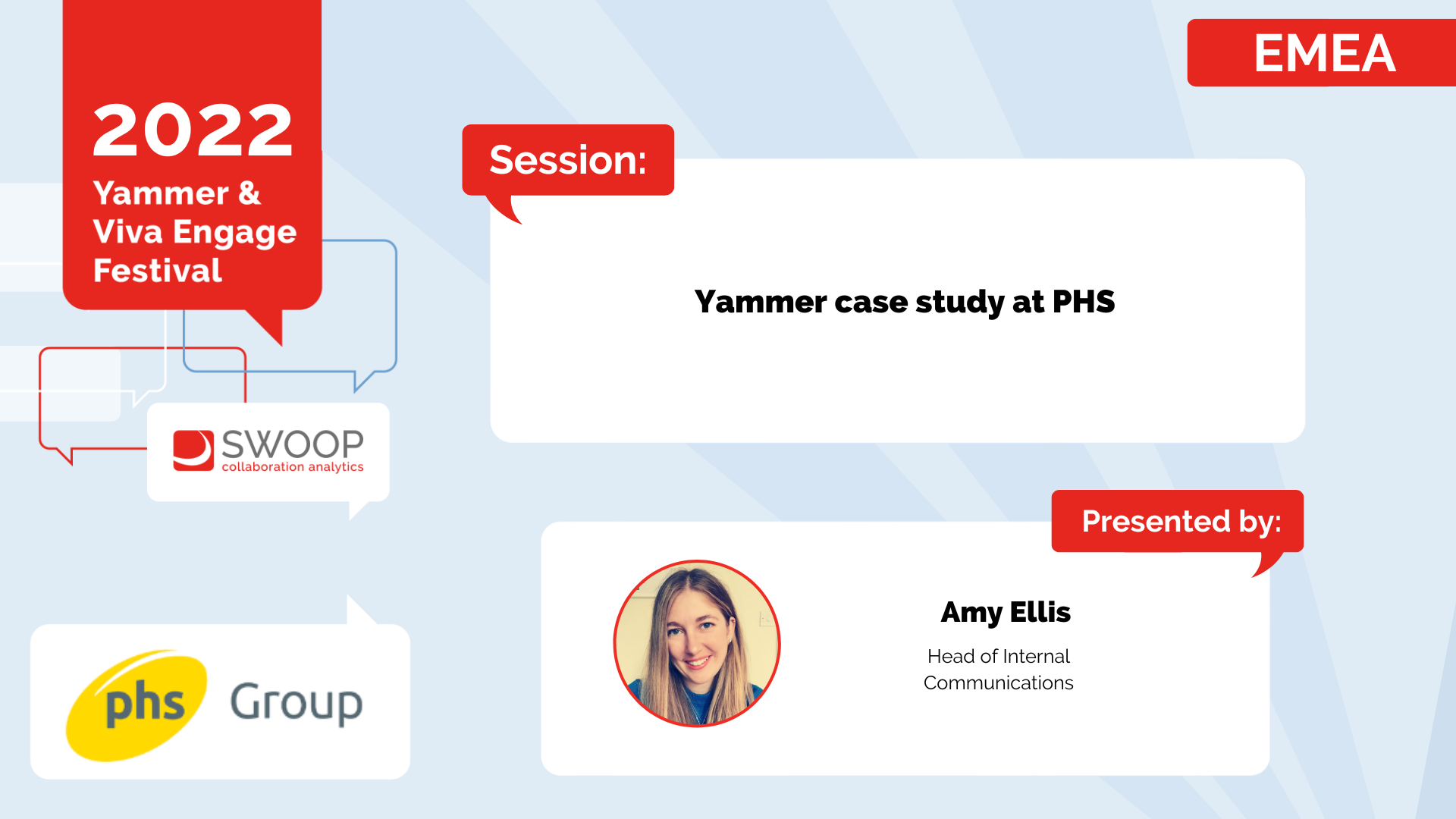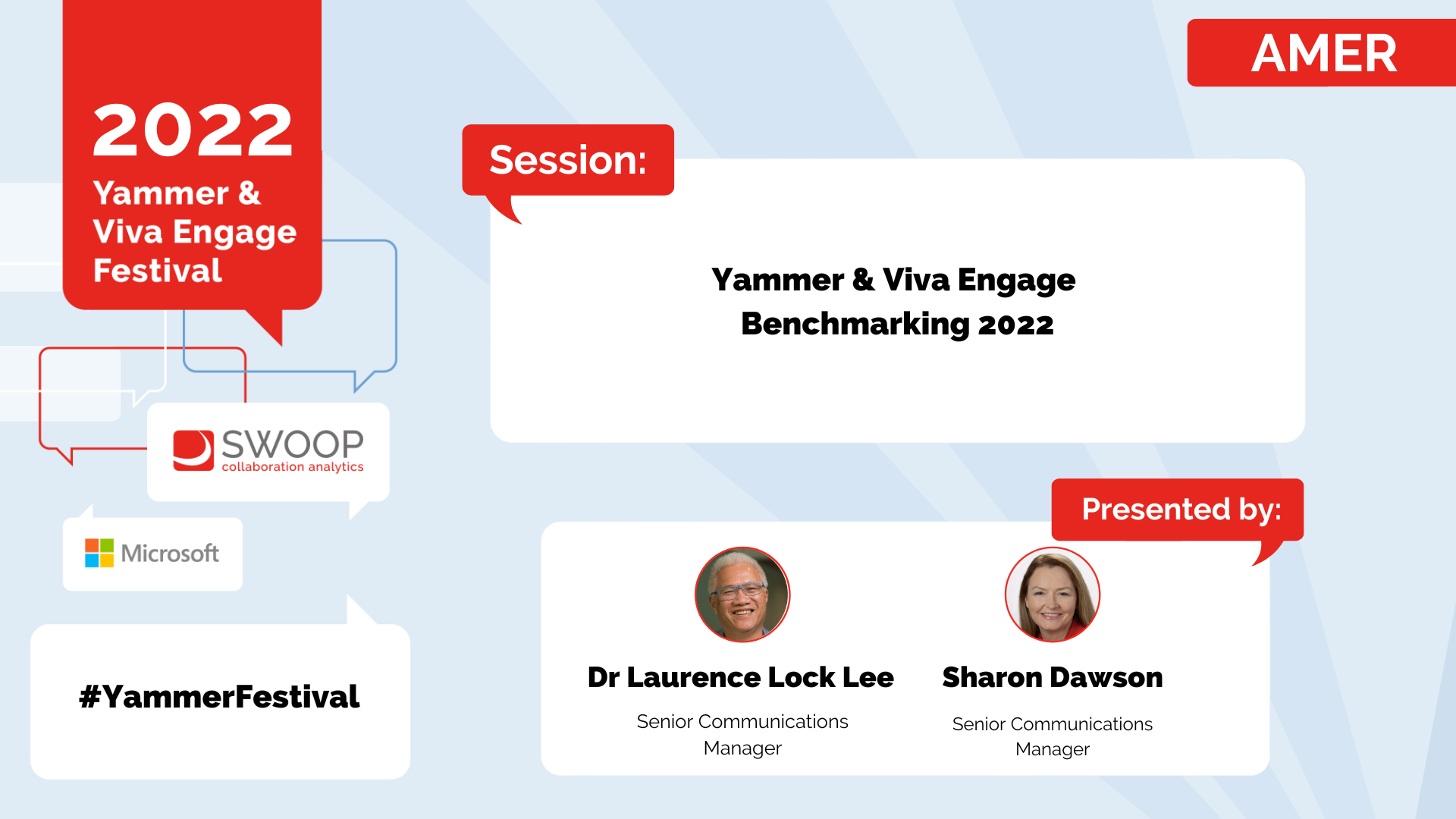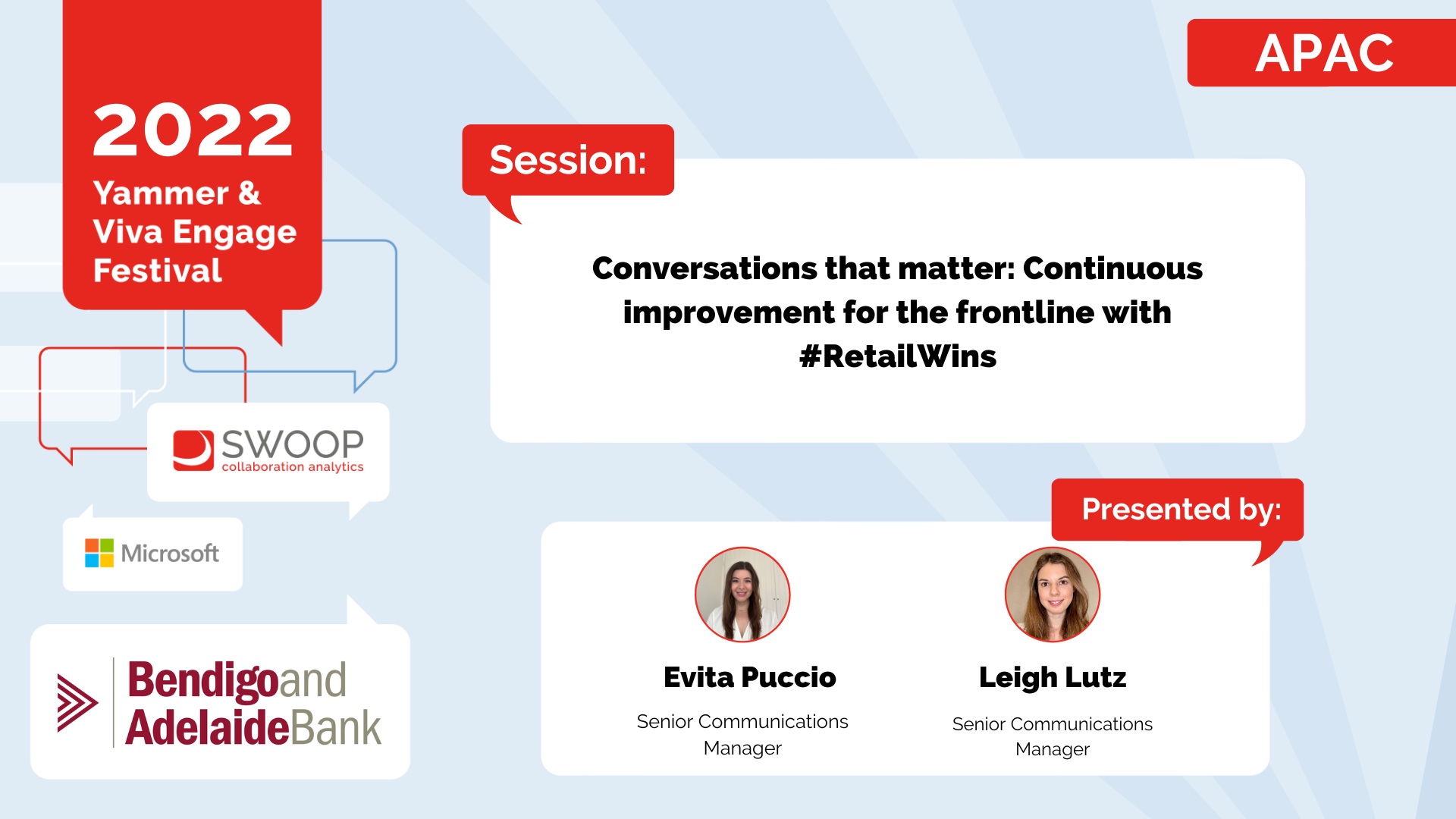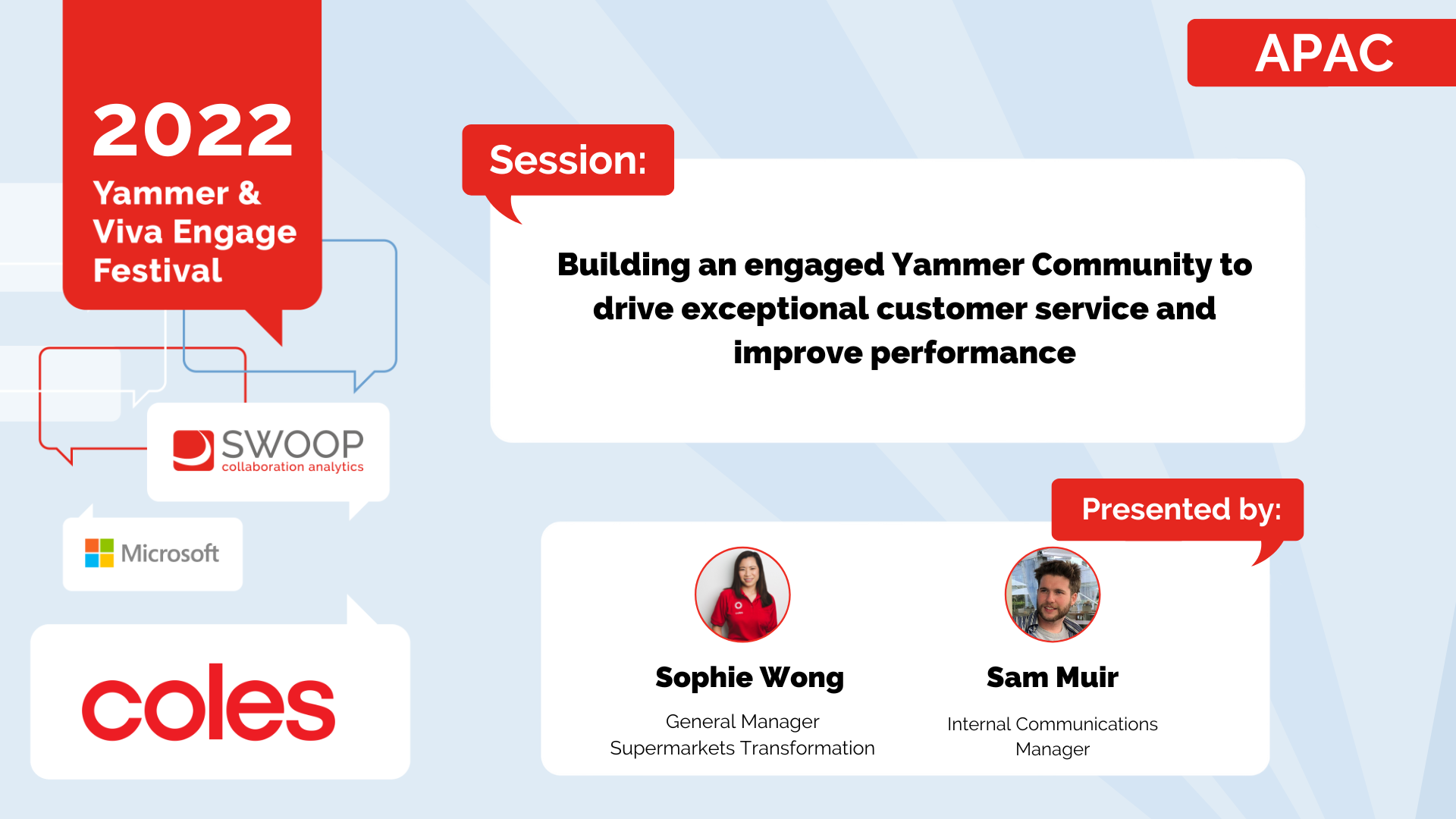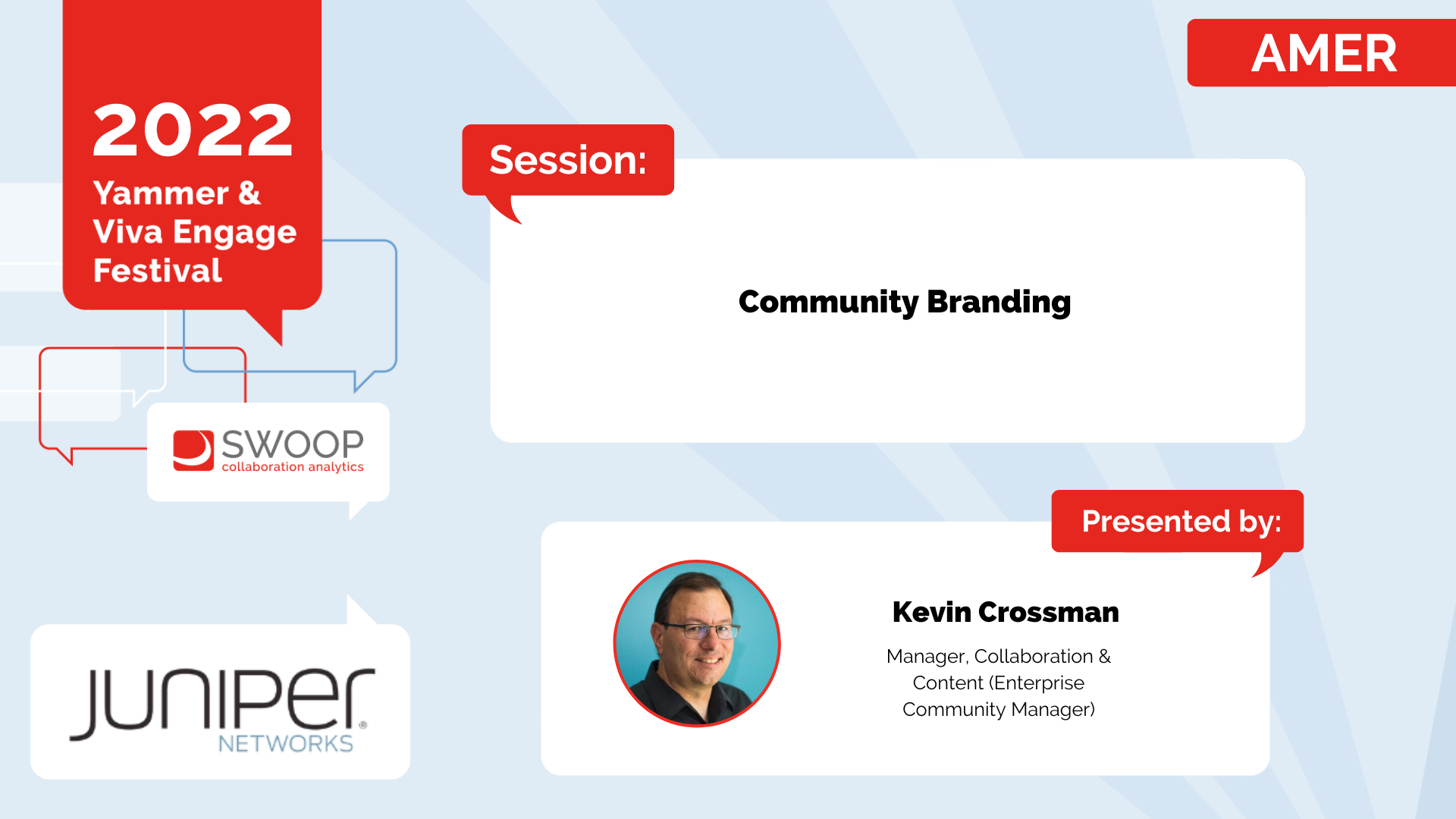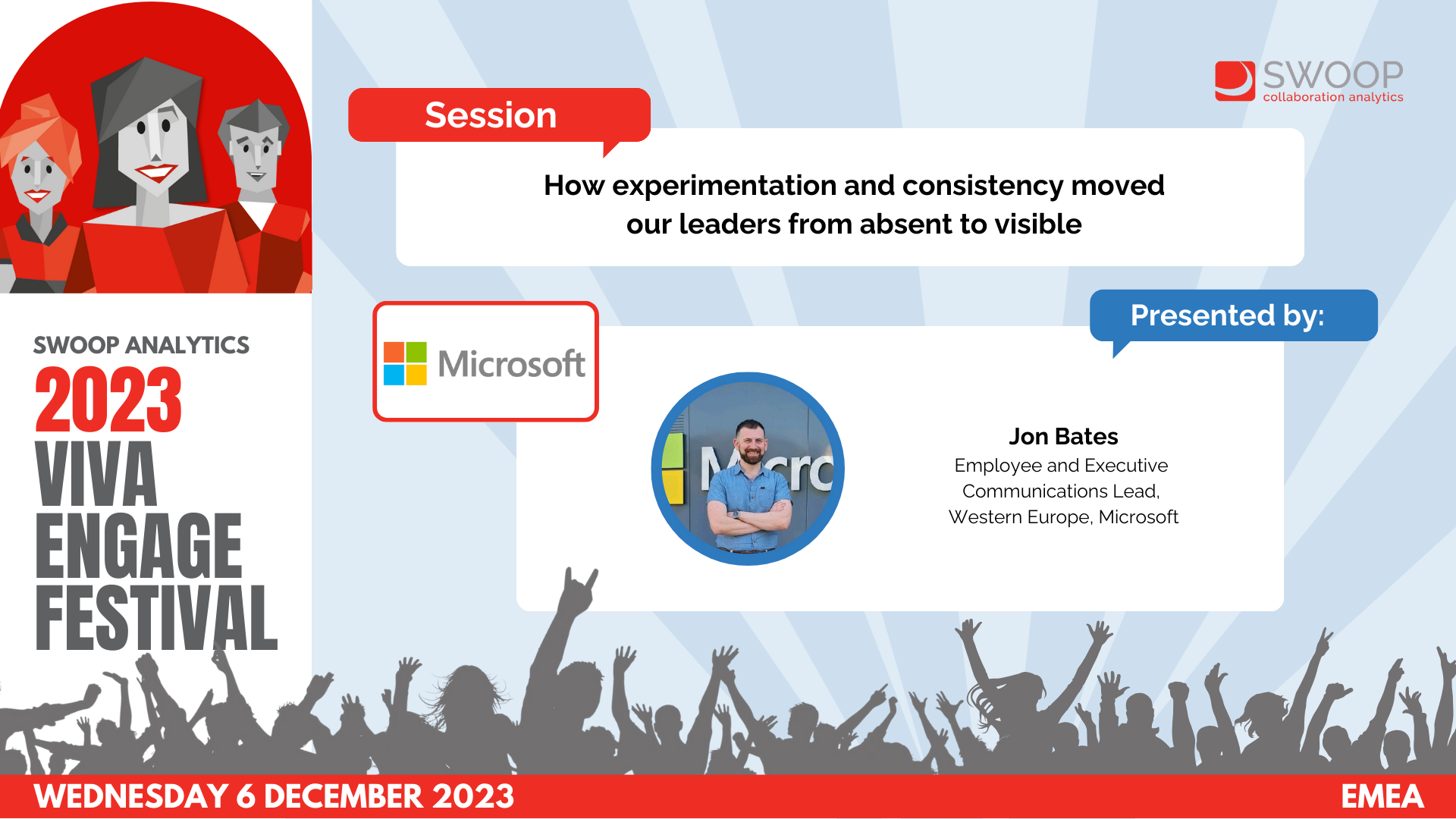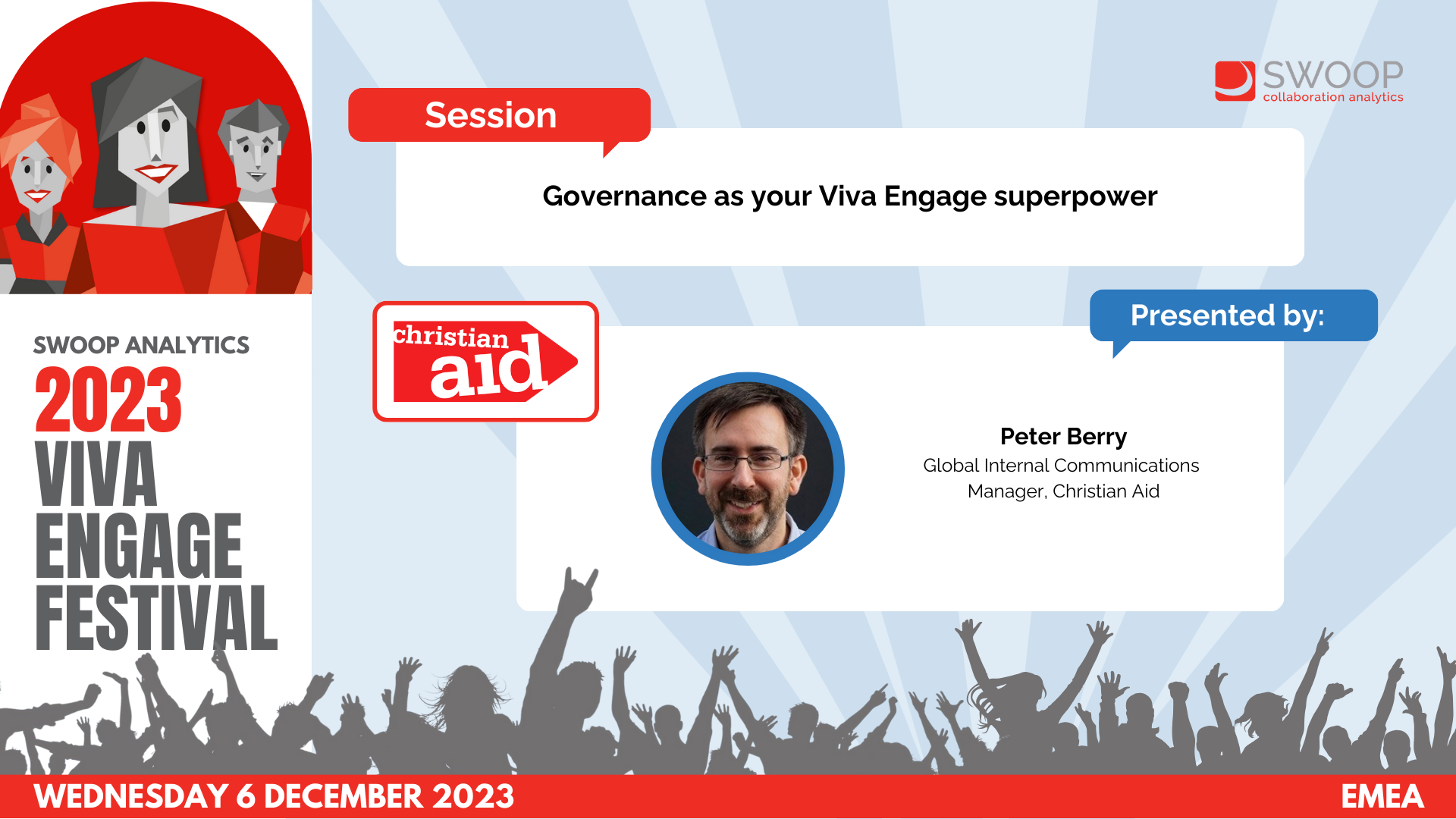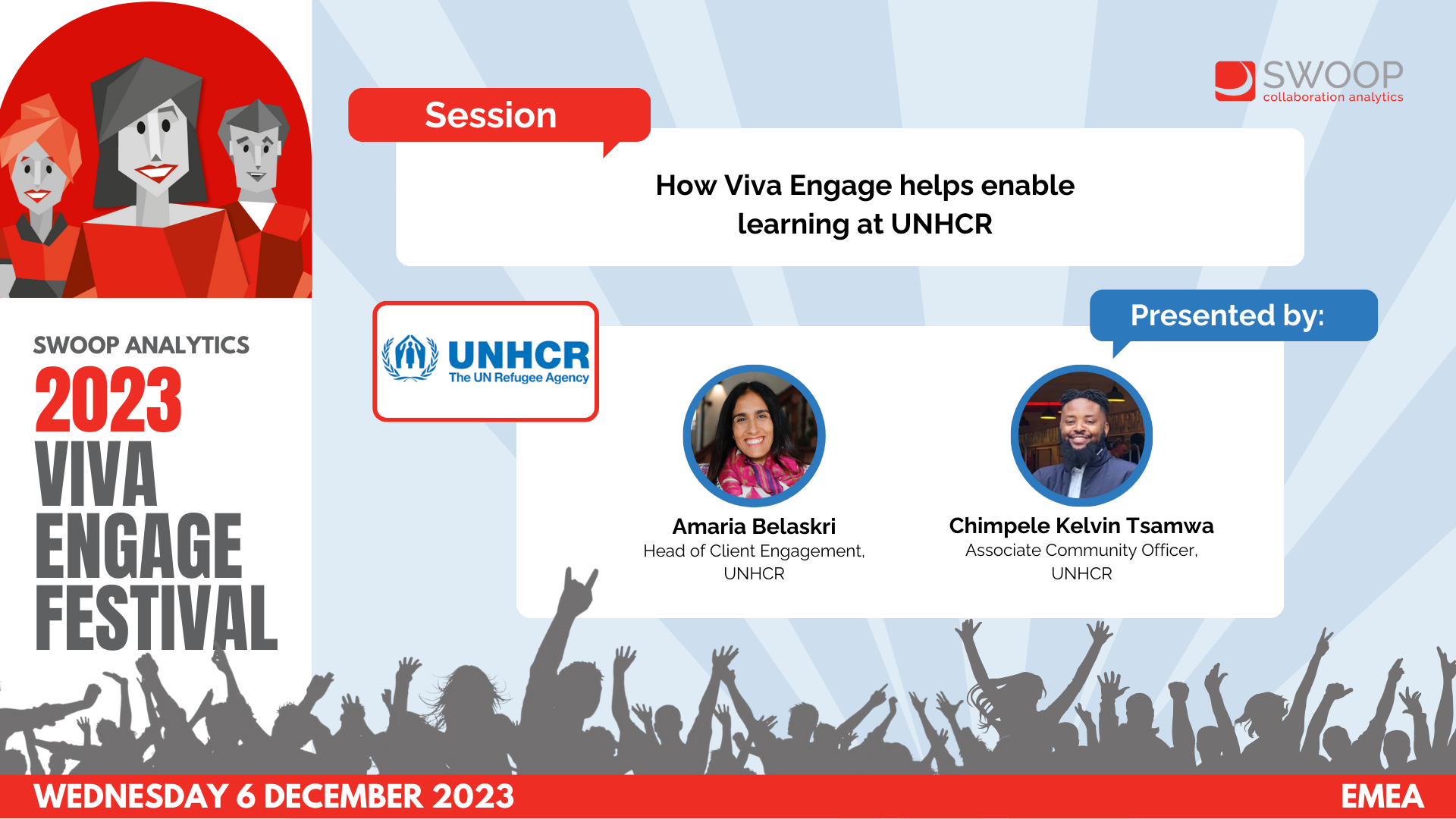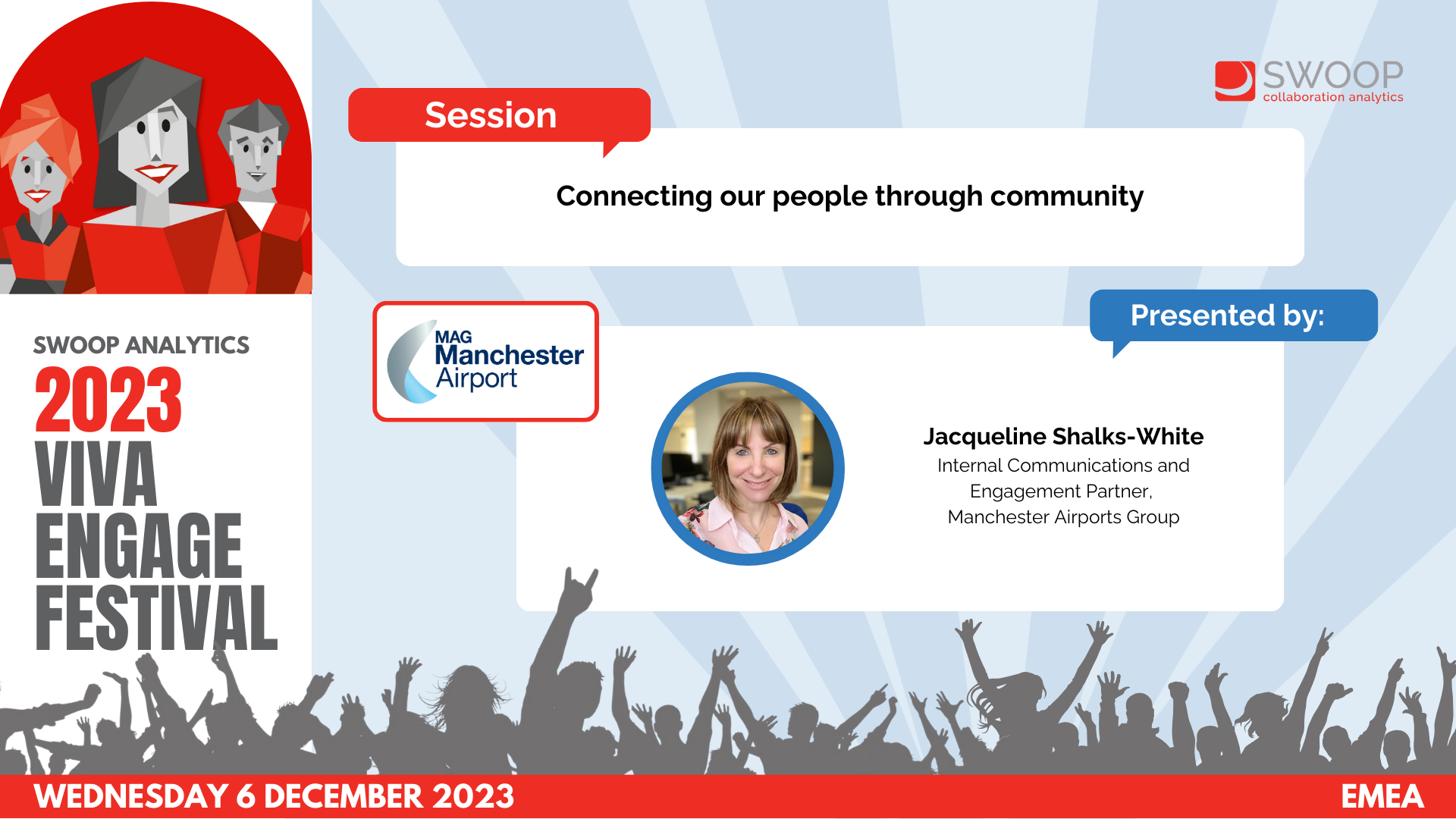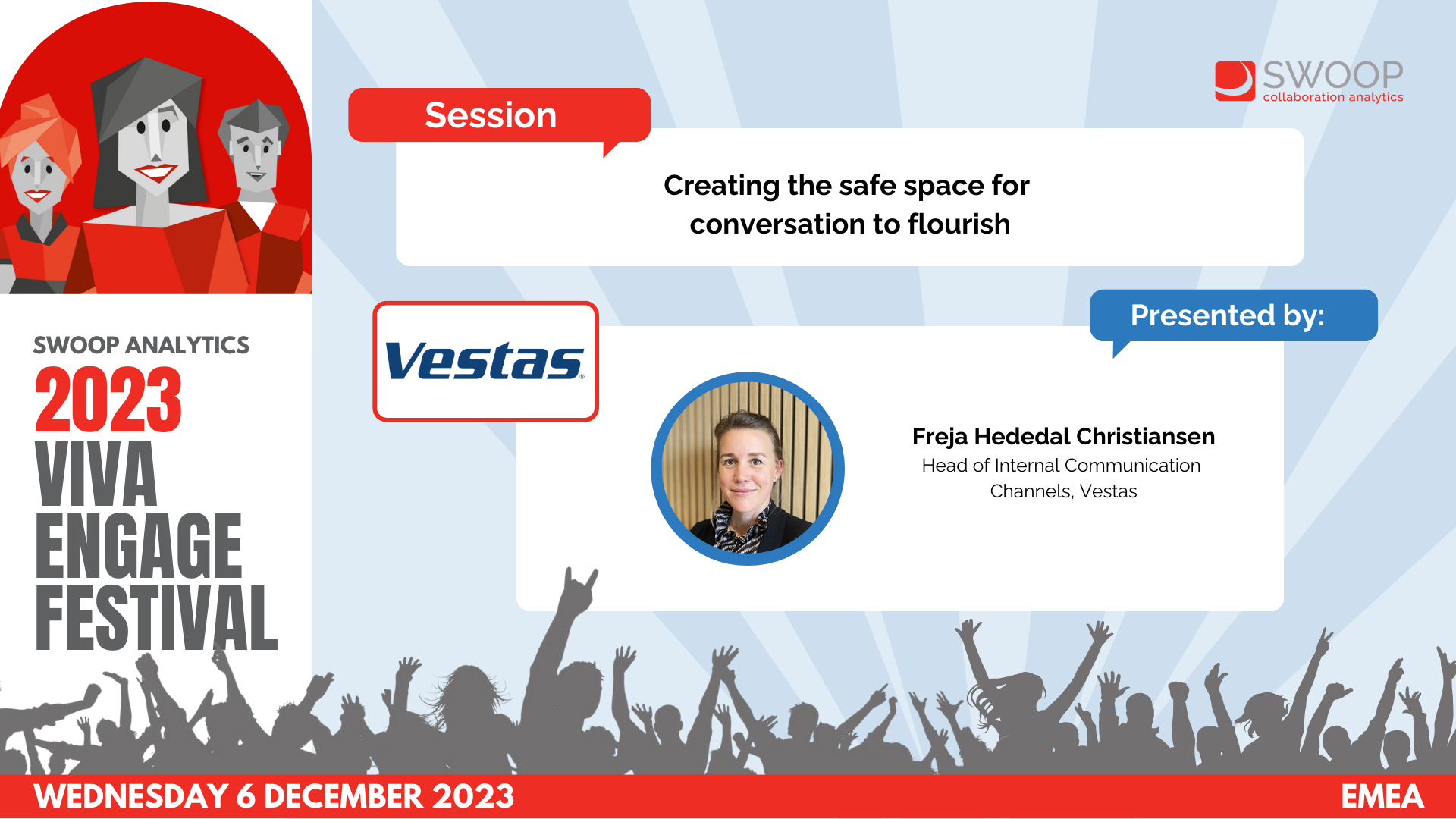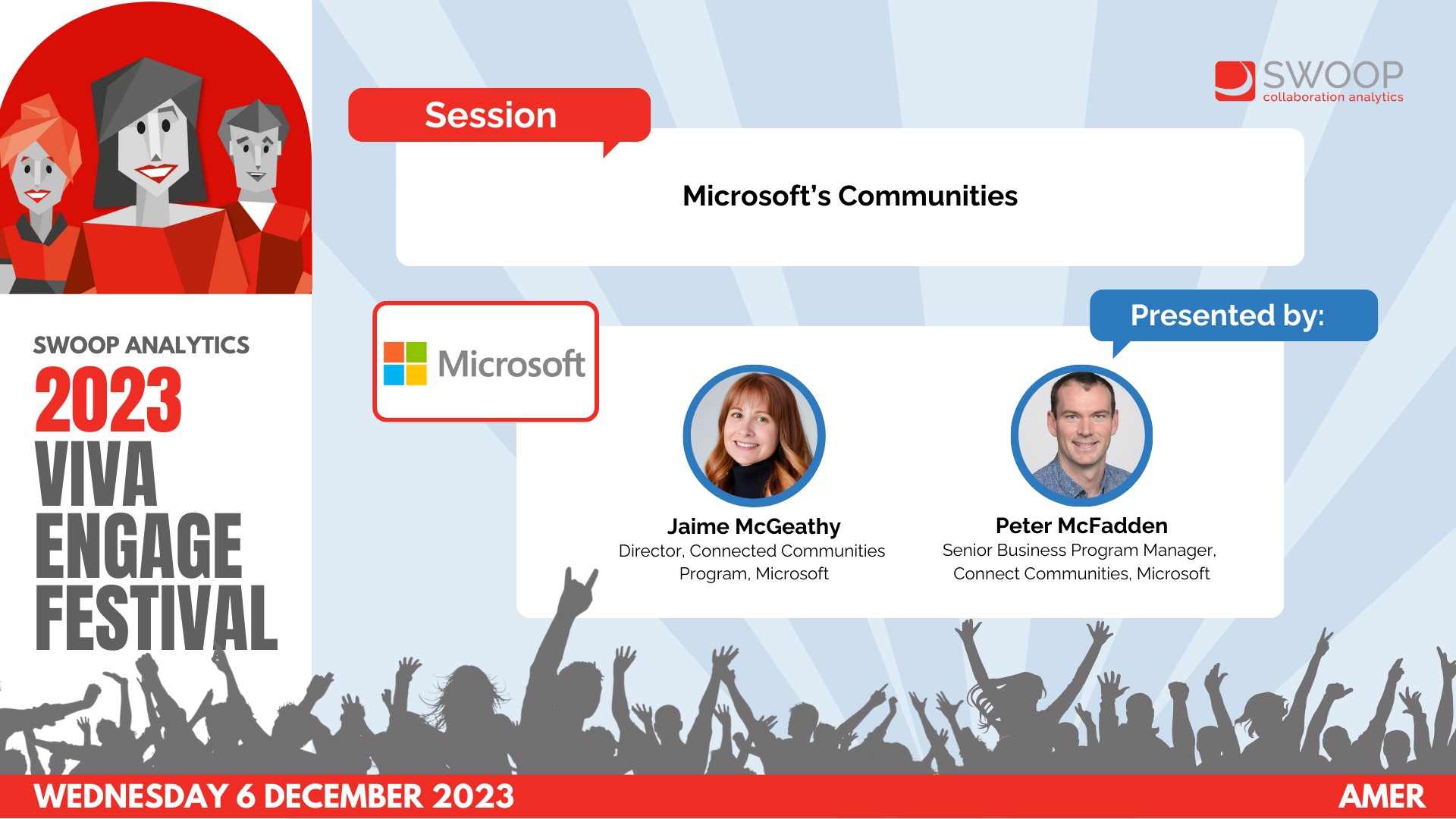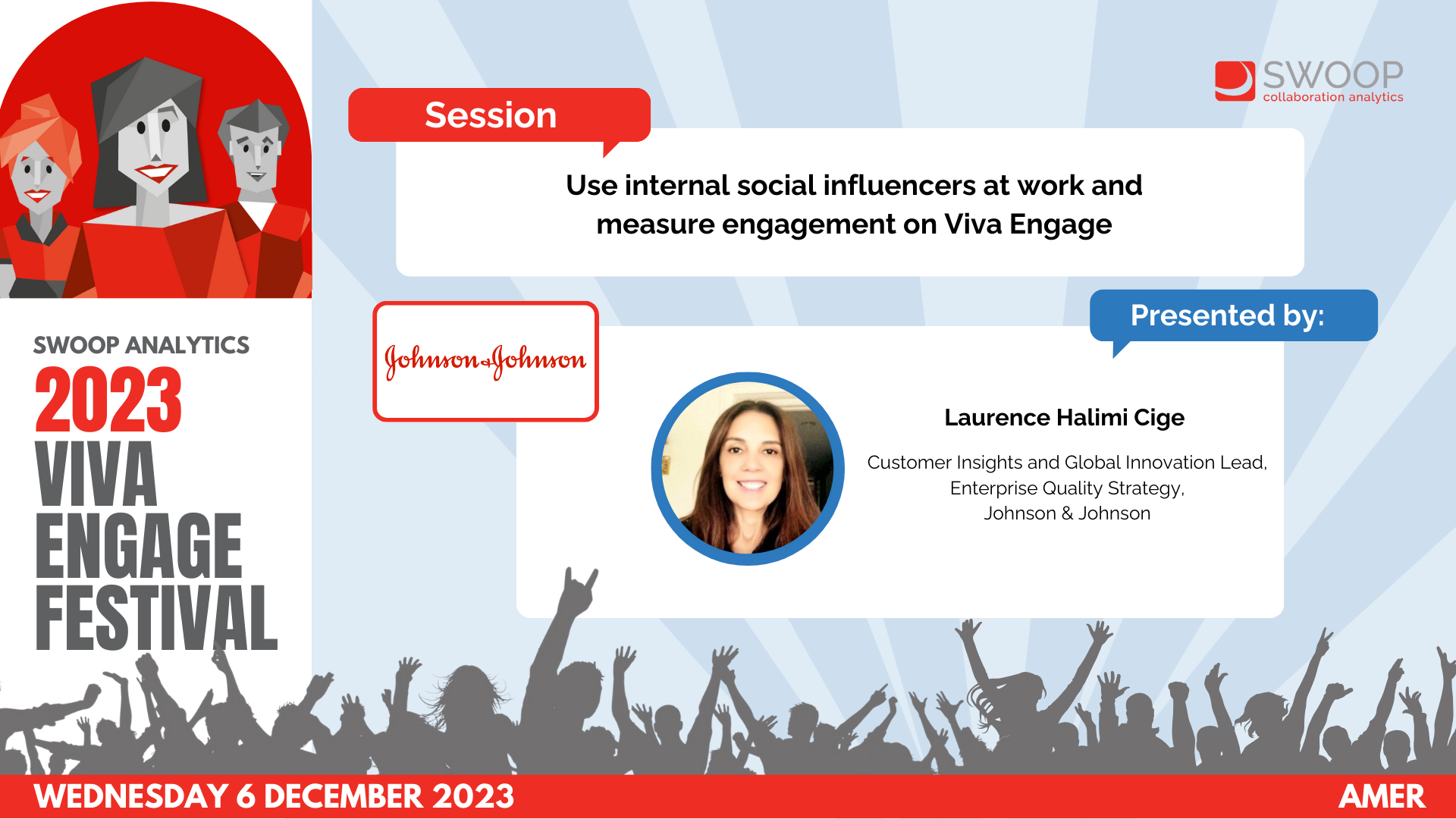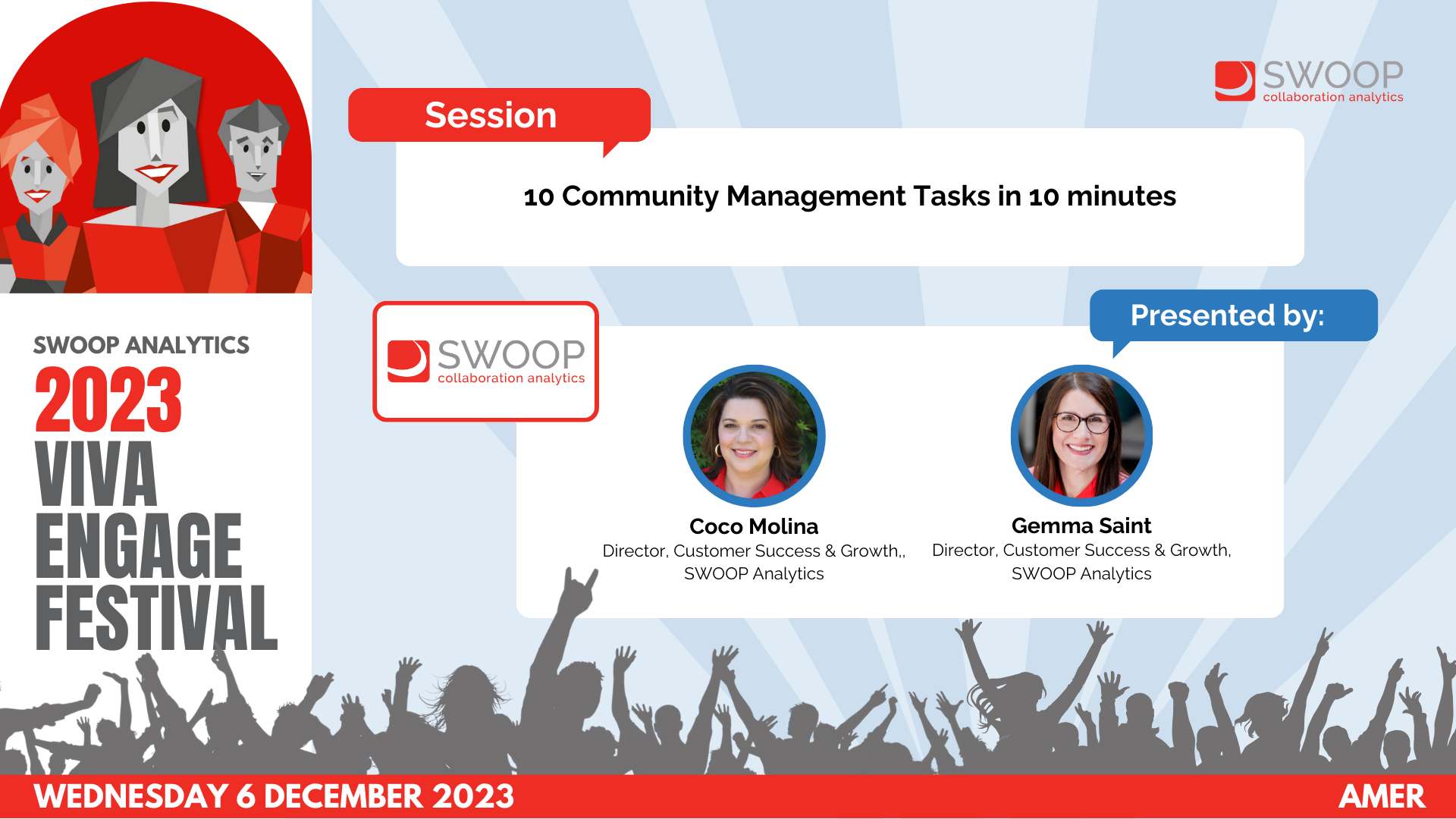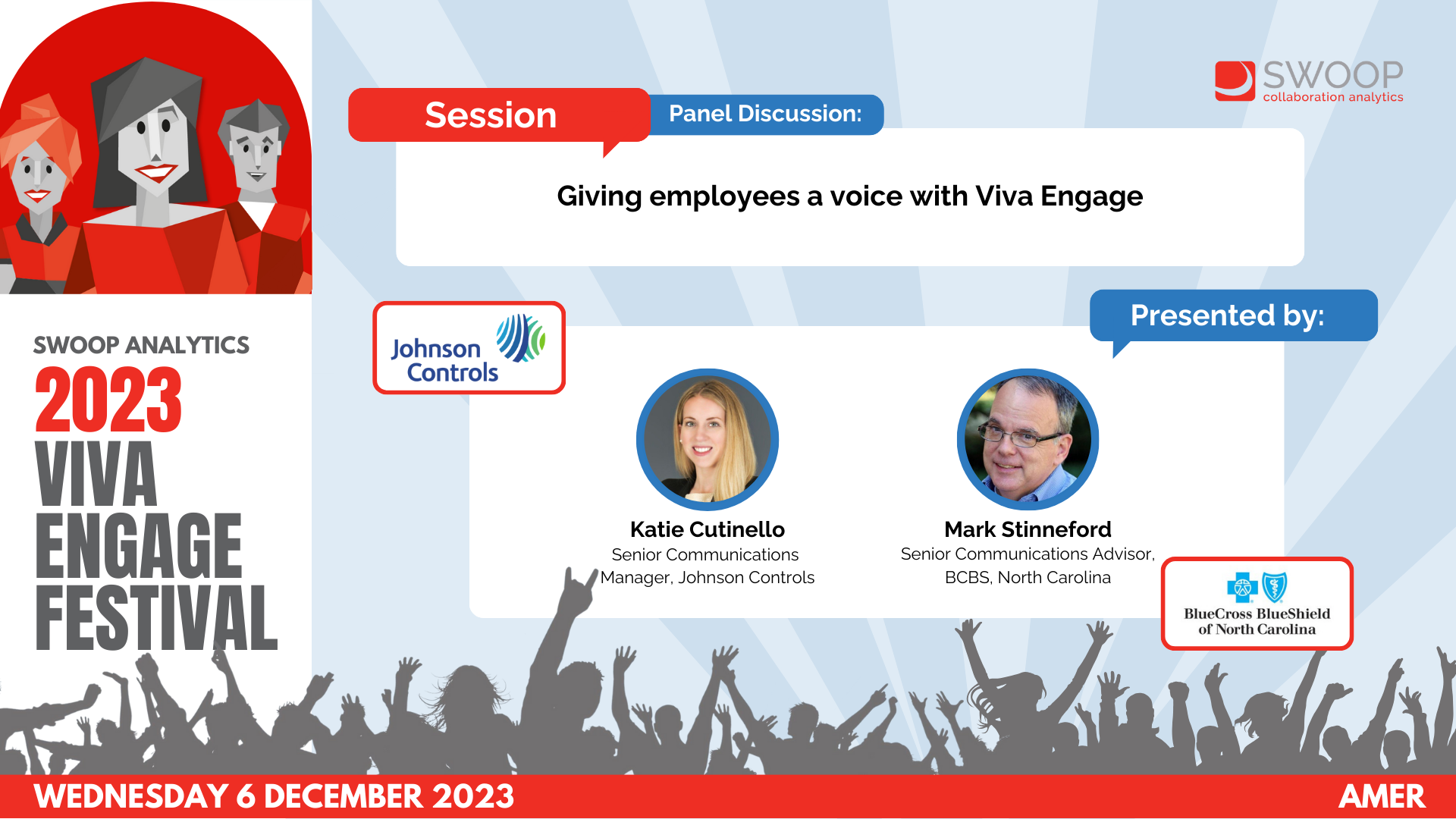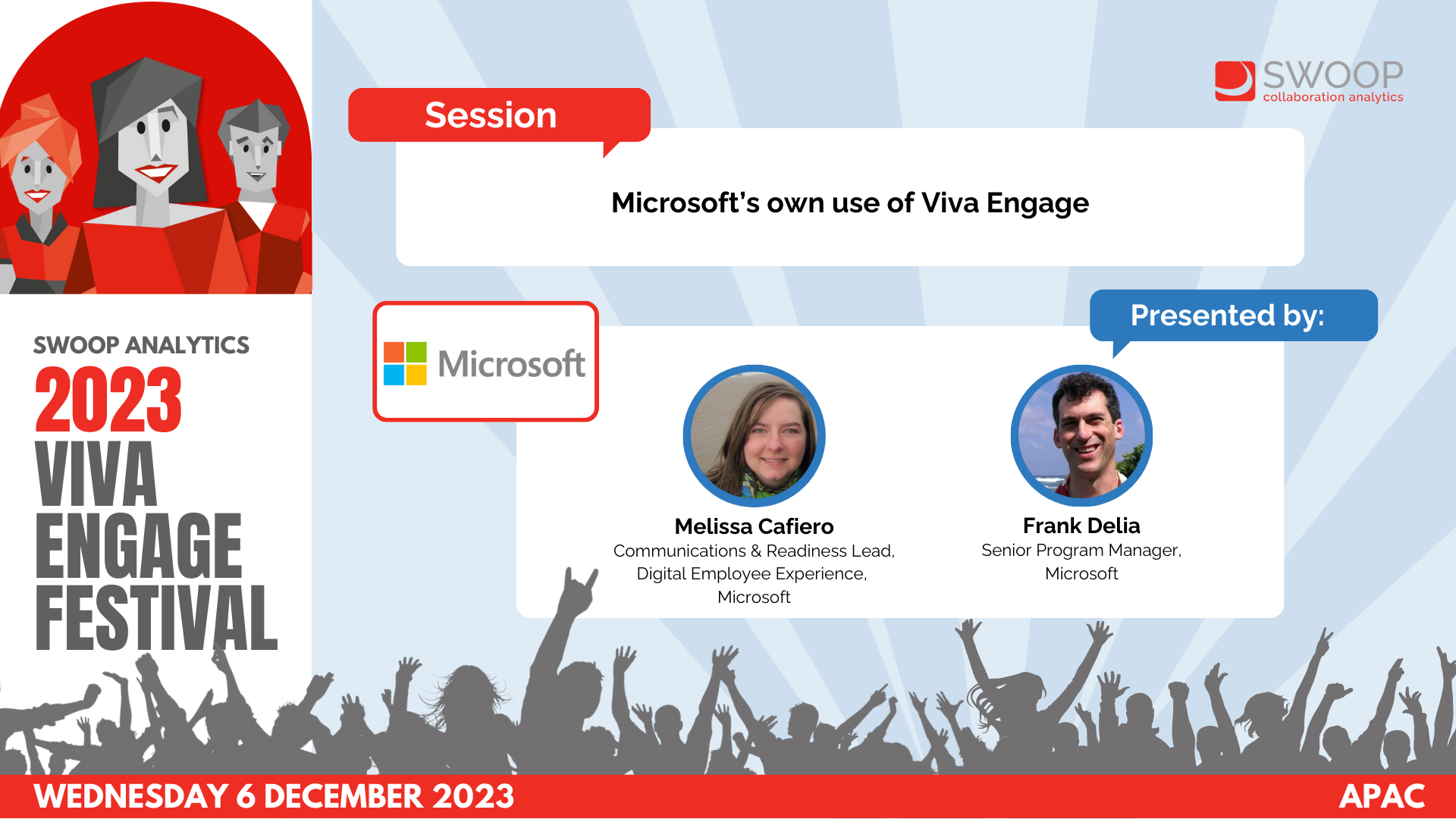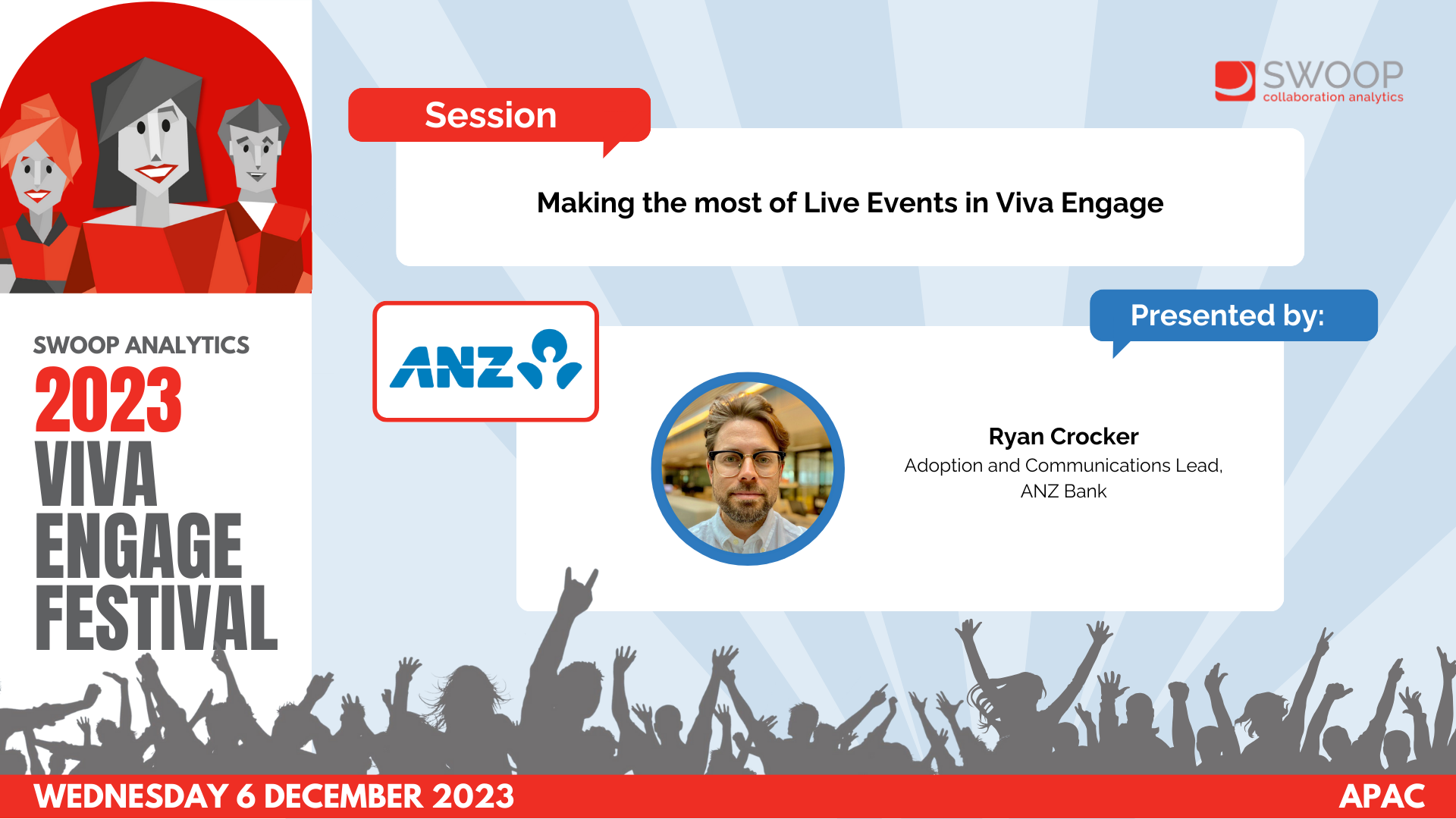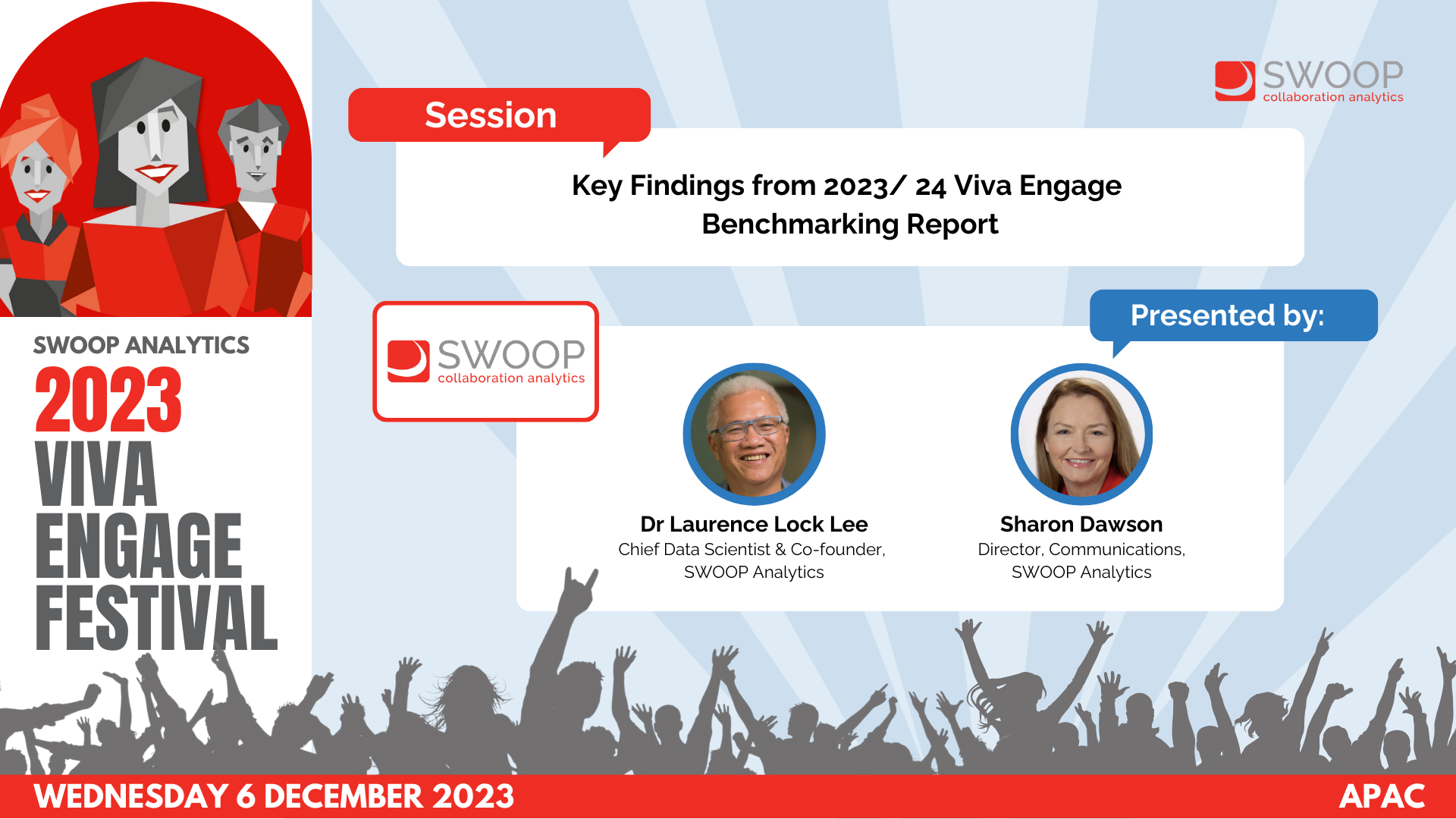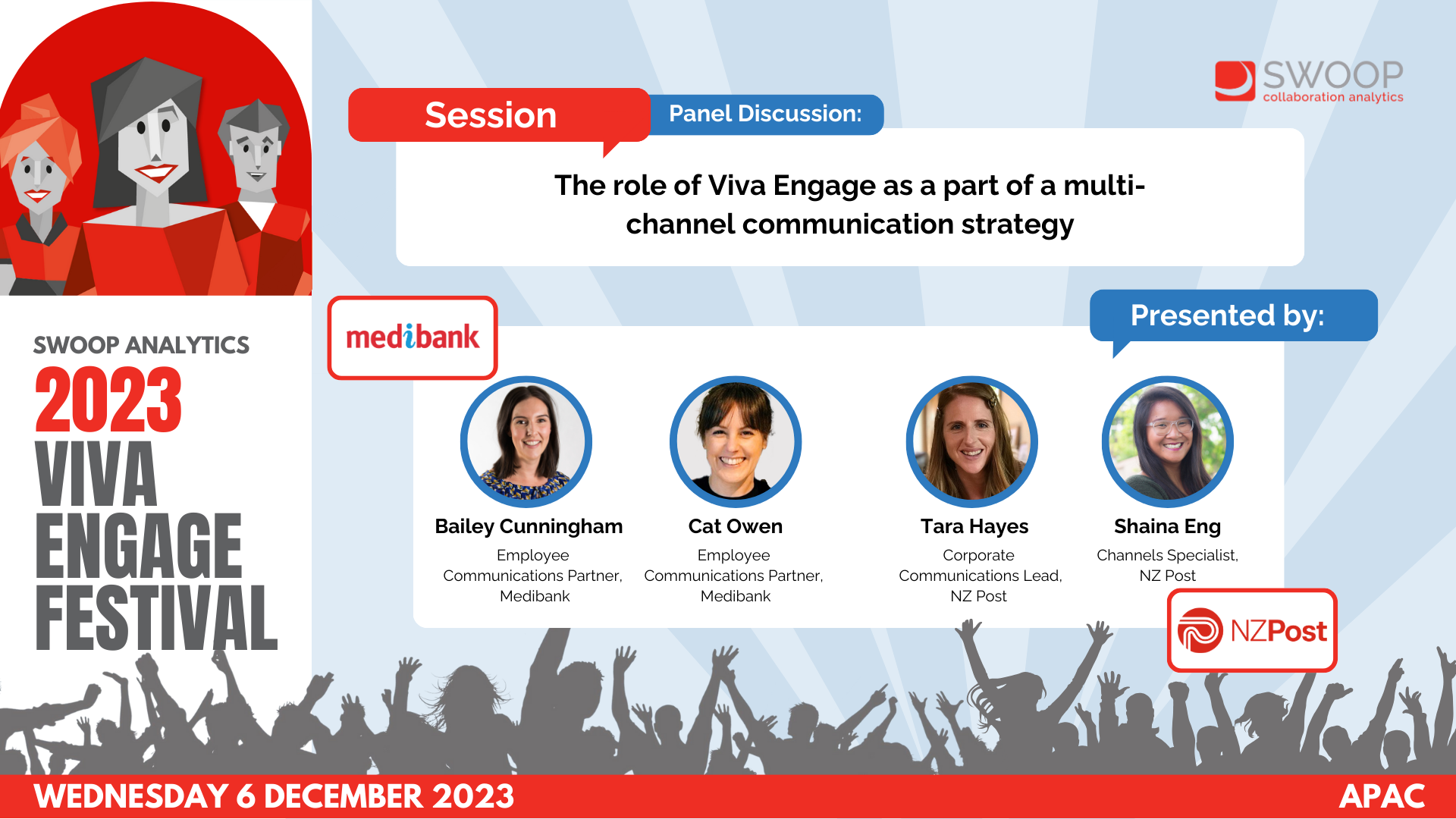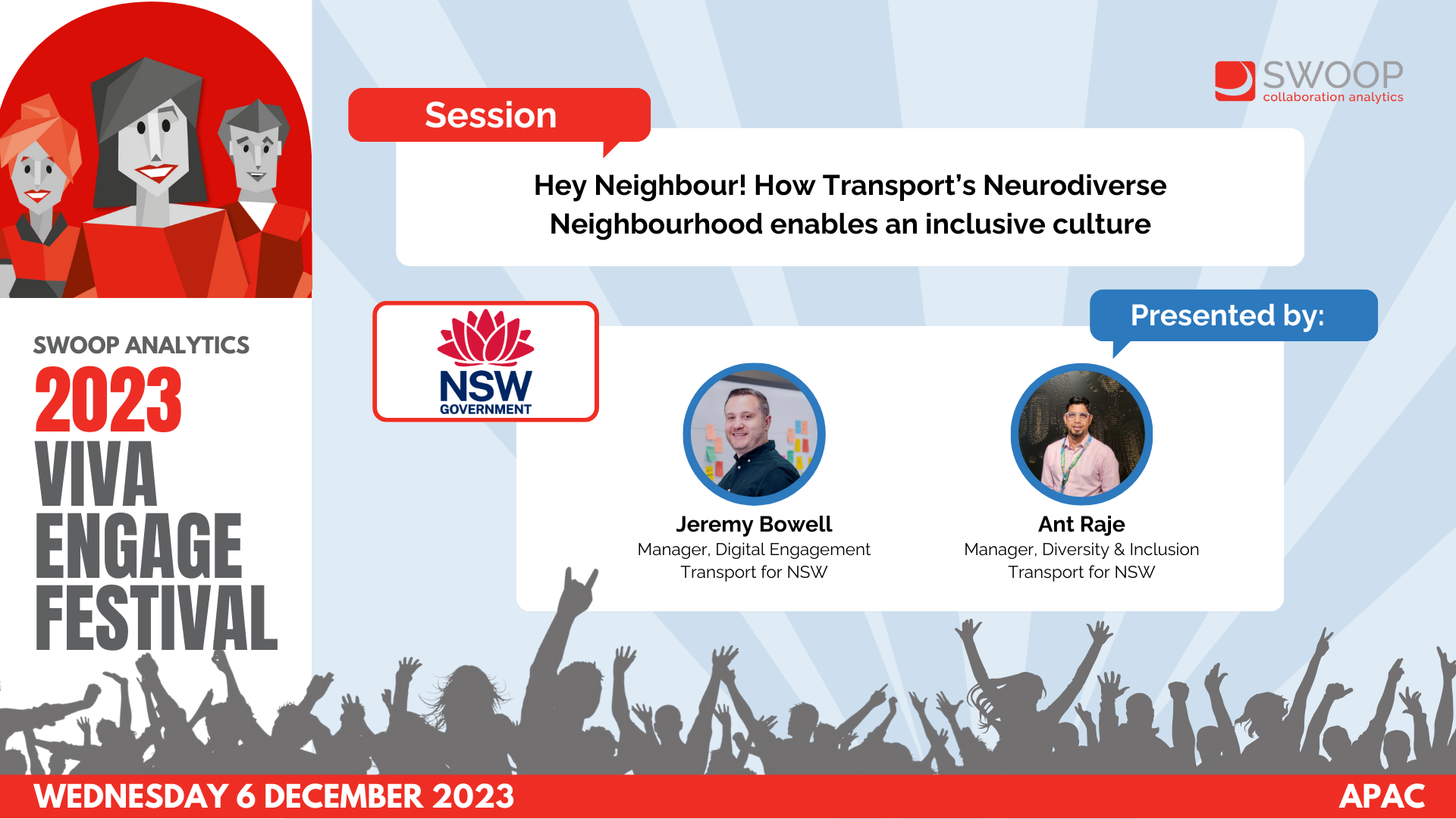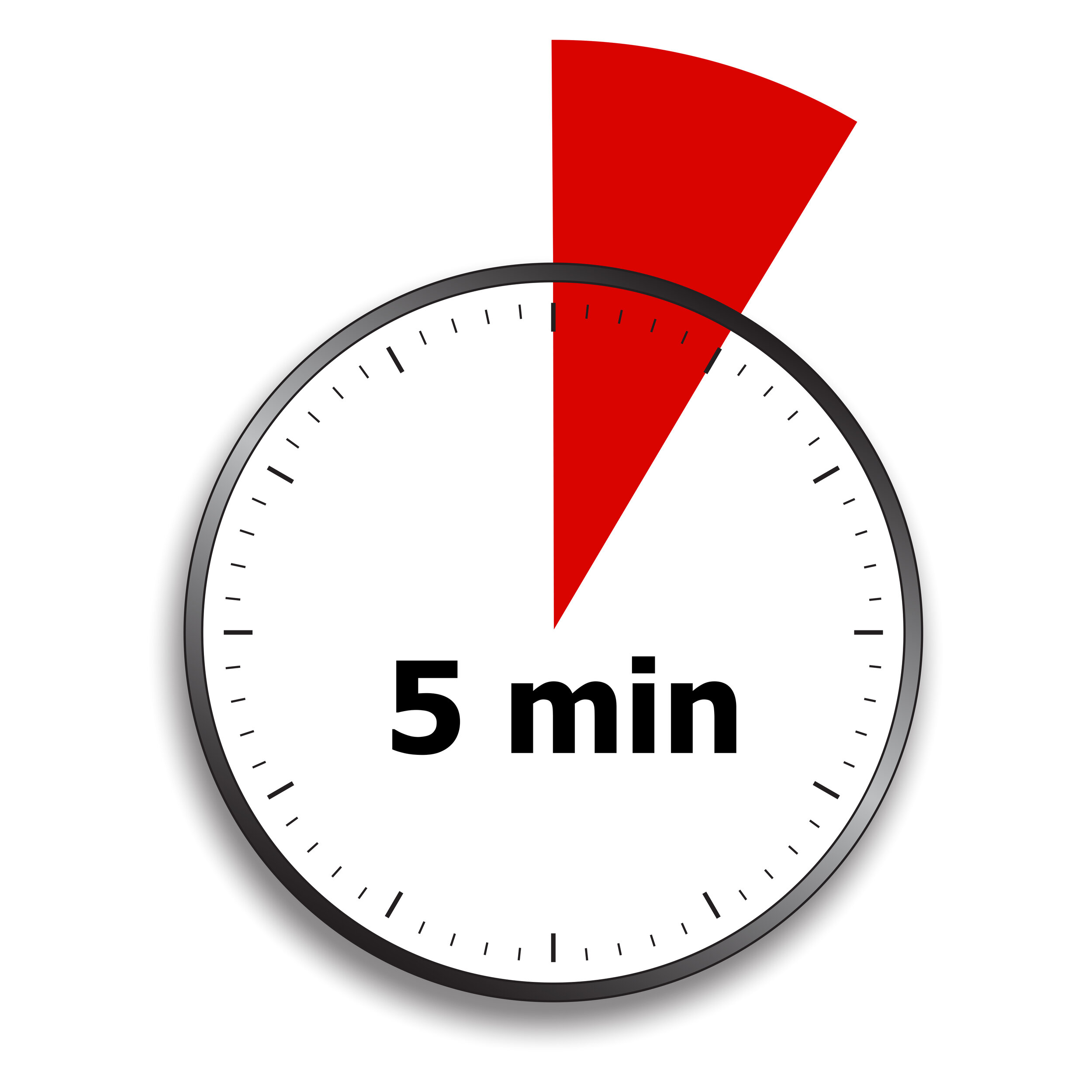Marks & Spencer: Yammer Case Study with Q&A
EMEA | Yammer & Viva Engage Festival 2022
Find out how Michael Kissman from Marks & Spencer built a thriving Yammer network that promotes care and humanity during difficult times. Learn how to make Yammer a safe space in your company and give everyone a voice so that communication can flow freely throughout the organisation.
-
Good to see all the different countries that are dialling in. And just before I share my screen, what I want to do is really just tell you a story about what we're doing at Marks & Spencer, about how we've used Yammer to create a real space for emotional and human response and engagement, how we've created a space to deliver operational information, how we've delivered a space to have honest and sometimes raw feedback, how we can move with pace, and how I hope we're engaging colleagues in a truly unique way. So if I just share my screen, and because I'm now in share screen mode, Pete, you can maybe let me know whether that's starting to load.
It's looking like it may be. Have you got a wide screen? I'm just seeing your initials on the screen there. OK, well, hopefully as it loads, so give me a shout if it hasn't loaded.
The thing I want to say is, and is it loaded now? No. OK, well, there is a picture of a 90s reference, film reference, which I will try and reload in a minute, which is of Neo and the Oracle from The Matrix. Now, and the reason I wanted to share that is because I'm saying I hate these presentations because, you know, you're all supposed to be industry experts, and actually there's people with great expertise on the call.
I'm just going to share it again. And I just want to say at the outset, I'm not the Oracle. We're not doing necessarily the next big thing.
We're not the one. This is just our lived experience of Yammer in our organization. So, you know, as we go through, I'd love to hear in the comments your experience, and we'll take it from there.
So I'm just going to share again, and then hopefully this time it will work. Yes, it's working. If anyone cannot see it, please exit and rejoin the meeting.
But it is showing up. So this is why I'm not the Oracle, it's just our lived experience. But as we know, there are people from all over the world joining.
So I just wanted to do a very brief one minute introduction to M&S. We are a clothing and home and food retailer. That's what we do.
And as you can see, sequins are very in this Christmas. So selling very well. Busy time for us, obviously, in retail.
But predominantly UK based, we do have a franchise international presence. But we are powered by our remarkable people. We've got 70,000 colleagues in these business units supporting us selling the clothing, the home products and our food.
And a very diverse, geographically diverse audience on the front line who have traditionally been very hard to reach. And in my role in internal comms, obviously, being able to do that is critical. So if you look at the journey we've been on at M&S, we have invested heavily in the Microsoft platform.
We've got a great relationship with Microsoft. And I know Nick is following on from me from Microsoft and is one of our partners. We've been on the Yammer journey.
It had its ups and downs. And I think if I had to sum up the history of Yammer at M&S, it's probably created a bit more heat than light. It created a bit more noise in the organisation.
It created lots of chats and it created lots of notifications. Probably too much. We then moved on to launch Teams.
And we launched Teams just before Covid hit. So it was almost the perfect timing because Teams came into its own, as we know, through Covid. And we've actually got Teams embedded all the way down into the organisation.
So every single colleague, every single one of our 70,000 colleagues has access to Teams. And Teams is now the front door to access not just comms, but your pay slips, your shifts, your rotas. And that's really embedded Teams within the organisation.
The mistake we made, though, is we tried to use Teams to communicate at an organisational level. And I think Teams does what it says on the tin. It's to talk to your team, not to your organisation.
So we had to take a step back and look at what we're doing. And that's where we launched what we called Community. And Community is for everyone on this call, basically Yammer.
But we re-skinned it and we re-branded it because of what I talked about before, about the noise that had come with Yammer. We'd burnt its brand a bit internally. We hadn't got off to a great start with Yammer.
But we knew the power of the platform. So we wanted to change the way that we used it. So we re-branded it and we created a new look and feel.
And this is the way we described it. We said goodbye old Yammer, hello Community. The new M&S social app launched in Teams where all 70,000 of us are invited.
And it's where we can have honest two way conversations across the whole business and a platform built around you. So that was the branding and the look and feel and the tone that we went for. And we launched it earlier this year with a whole suite of campaign material, which I'm sure you've done similar in your organisations if you've launched any kind of platform.
And you can see towards the left there what it looks like on your phone. You come into your Teams app and the little U symbol, the community, is accessed straight through Teams as Teams is your front door. It is basically Yammer.
It is Yammer. We just re-skinned it and we work with a fantastic agency called MGA who helped us design this up and promote it. And what we did is we, the way we changed it is we locked it down.
So we started from a position of noise and we went to a position of only having about 50 senior leaders that had access to post in this all company Yammer group. So everybody was in the group, all 70,000, but only 50 people could post. And we created an air traffic control system.
And me and my team agree and manage and curate the content that goes on there. However, we completely unlocked responses, likes, reactions and comments. So we created it where our leaders were conversation starters to a curated plan to manage the noise, but allow freedom of interaction on those posts.
And if I give you an example, and although this isn't a leader, this is actually an account that we set up for Percy Pig. For those of you who know M&S, you'll know this brand very, very well. Those less familiar, let me assure you, it's one of our biggest brands.
But Percy celebrated his 30th birthday this summer and we wanted to create some interaction and a moment with it. So we created an account for Percy. And as you can see, this post was seen by 37,000 people.
And we asked for interaction. We asked people to like the comment, sorry, like the post and leave a comment about their favourite memory of Percy. And we had hundreds.
And there was a strategic point to this. This is one of our, you know, this is a multi-million pound brand in the business. We want colleagues to be ambassadors for the brand and celebrate the moment.
And it was a way of drawing out the emotion, the celebration that there was for Percy across the business. And we got hundreds and hundreds and hundreds of responses. We also remember around the Jubilee in the summer, we knew there was a huge sentiment.
We'll come on to what happened later in the year. But if we go back to May and June with the Jubilee coming up, huge moment. You know, we're a heritage British retailer.
We knew people had their stories about when they've met the Queen, met the royal family. And we asked, tell us, share them as an organization. And again, we had hundreds of responses come in.
And it was a great way of people being able to share their moment, their celebration. All linked back, of course, to our trade and commercial calendar. The Jubilee was a huge trading moment for us.
But we also wanted people to be able to share their personal and human feelings about the moment. And then what we do is we amplify this content and then recreate it and turn it back and share it back with colleagues. And I'll show you what I mean on the next slide with a short video we produced with all the content that was almost crowd surfed from our colleagues.
Here we go. Oh, no, sorry. There's another video coming up.
I also wanted to share just before the video that it was honest feedback. So although there was all this celebration, there was also people who and we didn't edit this. Because the community self-regulated itself, that we know not everyone was a fan of the royal family.
And that's fine. You know, people were allowed to share their own view as long as they weren't rude or disrespectful. We didn't edit.
We allowed people to share their view. And there was still like the old Yammer, the odd random post that despite curating content and asking for feedback on a very specific subject, the odd colleague does still use it as a help desk, which I think we've all seen in organizations with Yammer becoming a help desk. But this is now few and far between.
The good news is we got loads of great sentiment. And here's the video. I'll pause it there, but you get the sentiment and it was great.
So not only do we ask for the content, we then feed it back to colleagues and show that they've been heard and share it around the organization, you know, telling the stories in their words. You know, and just in case you missed it. Yes, I did meet Prince Charles before he was included in there.
But the serious point, and this is where I think the swoop analytics come into it, by curating content and really managing what we post, we had 100 percent of posts with replies and reactions. So no tumbleweed moments, no dead posts, no talking into the darkness. We were really careful and planned to make sure we were putting out posts that really connected with the audience and got engagement.
We also learn in the early days that time matters. So that first golden hour is when we get the most replies and reactions. And the first day is about 75, you know, three quarters of all reactions.
And then it starts to tail off. So this is an in the moment, almost intrusive because we're giving an announcement, it pops up on your phone. We're telling people to do something in the moment.
Come and tell us how you're feeling. So I thought the pace and the interactivity was really interesting. And that would have been very different when Yammer was just opened up for everyone to post what they wanted.
We also used the swoop platform to learn about the sentiment and the connection. And this helped us improve posts over time. So the post towards the top there from a colleague called Cara, she made a suggestion to the business about bowel cancer, having suffered from bowel cancer herself, that we should put information about the symptoms of bowel cancer on all our toilet roll packaging and in the toilets of all our stores about the symptoms to look out for.
She posted about that and the emotional response was huge that we received. We also learned how to support our leaders be better communicators. So at the bottom there is the data around our managing director of clothing in home who posted about Father's Day.
Again, a big commercial moment for the business. We need to talk about Father's Day. It's a huge gifting opportunity.
But Richard talked about his family and his daughters. And what the swoop platform helped us do was understand how him talking in a more personal way helped connect with the audience. Then if we fast forward to September, and this is the case study I really want to show, because this is the biggest response we've had on community, our Yammer platform, since we launched it.
On the 8th of September, obviously, the Queen passed away, which in the UK was obviously and worldwide a major moment. We had various things to grapple with as a business at that moment. How do we communicate with our colleagues? How do we get them to share their feelings? How do we say that we understand how they're feeling? How do we give them operational information about how we're going to trade our stores? Are we going to open on the day of the funeral? When are we going to make that decision? So there were many different things to get right in that moment.
And every organisation, I think, was going through this. So this is just an example of how we did it. So on the very, very first day, on the 8th of September, the day the Queen passed away, our chief executive, Stuart, posted a message as an announcement on our M&S community, Yammer, which was seen by 50,000 people, which I think we've got about 60,000 live on the platform or so.
So, you know, the vast majority read this. And it immediately received 823, I think it says, comments, which was his opportunity to, instead of going through a cascade through line managers or messages through HR or a post on an intranet, going directly to colleagues with an announcement sharing how he and we feel as an organisation, but also to phase into the fact that we know there's going to be some operational updates that need to come. Don't worry, there will be further communication.
We will come back to you. But for the moment, we've paused social media. So it was a very quick response and really appreciated the comments from colleagues.
They felt communicated to. They felt they knew what was going on. And we stopped the vacuum.
We posted again and again, kept people updated. And I'll be very honest. We started to get real feedback from colleagues about what they wanted us to do in terms of opening shops or closing shops on the day of the Queen's funeral.
And the feedback from colleagues was clear. We had thousands of comments back. You know, we should lead the way.
Don't wait for others. You know, there are thousands of comments. We should close our stores on the day of the funeral.
And this was brilliant because our CEO and our executive team were able to see the sentiment, the tone of colleagues in the moment. Now, as it happens, the leadership team, I think we're in the same place. You know, they felt the same way about what we should do on the day of the funeral.
But nevertheless, this gave us the confidence that we were making the right decisions because it was raw feedback in the moment. Which meant ahead of the funeral, we could go out with a very considered and this in some ways is not best practice for Yammer, it's a very long piece. But we also had a lot of information to share to again, go out, confirm that the funeral had been confirmed and to be really clear what we were doing.
And there was some subtlety in our messaging, because although we decided to close the vast majority of our 600 stores, there were some four that we decided to open after the funeral. And they were the ones very, very close to Westminster Abbey in London, where the funeral was held. And also in Windsor, where the Queen's procession ended for her final rest in place.
And actually, those stores being open were appreciated by the mourners who were in the area, who needed access to food, drink, etc. during the day. So we were able to get this message out.
And in the last paragraph, you can see we referenced that the feedback people had been given on community. So we closed the loop of feedback from we came out and asked you your view. We've now made a decision.
And this is what we're going to do. And it was all very transparent. And then again, the comments that came back and I've tried to take names out of it to make it less personal.
But you can see there was I think 900 responses that we received. I think we got four to five percent of the organisation made a reaction to the post, a like or a heart or, you know, a thumbs up or something huge. So it's a huge number just to just to actually respond.
And then a good 900 people made a proactive response to the post. So I think, you know, this is just an example of how we used it in the moment operationally to give people that chance to feedback, do it in an inclusive, engaging way. Allow views that maybe some organisations will be scared of who disagreed and the space for the emotional and human response.
One final thing, and I'll just close because I know we might want some time for questions, is we also use the team's platform for a suggestion scheme. And this is part of the wider ecosystem that we use Yammer and the Microsoft platform for. So we've got what we call straight to Stuart, which is our suggestion scheme, which, as you can see on the left there on a screenshot, you've got community, you've got our HR system.
We also have a scheme where anybody in the organisation can go straight to our CEO and our CEO will go back to them. He says within 24 hours, we're tracking at about five days, but we've had 6000 suggestions in since we launched earlier in the year. So actually 6000 people have had a response and we've also had 20000 comments.
And I think for us, that's a fantastic way of also including colleagues on anything that they think is important. From we've had people suggest that you should have a stammer symbol on your badge for people who find difficult speaking. So they're not embarrassed in front of customers through to what I talked about, about bowel cancer, to ideas about supporting cost saving in the business.
So this is a fantastic way and it's all built and comes off the back of apps that we use off the Microsoft platform. So I'll stop sharing because I know my session finishes at 35 minutes past. As I said at the start, I'm not trying to be the oracle on this.
You know, this is just our lived experience of how M&S is used to get some operational information out and share experiences in the organisation and Pete. With that, I'll see if there's any questions. Yeah, we've had a flurry of comments and questions, a lot of love for your presentation.
And I don't know if you could see as you were going over hearts and thumbs up flying through the air. But I might just pick a couple of questions or a couple of themes from the Q&A. And then after Michael, obviously, you can jump into the Q&A and respond to some of those questions if you have time to stick around for a while.
One of the themes that's come through just a couple of questions around the broader network. So you're obviously talking here about that kind of particular community where you've got these this constraint of the number of leaders that creates the safe space, actually. So one question came around.
Was that a launch strategy or is that an ongoing thing that you're constraining it to just that top sort of 50 people who can actually post? Yeah, no, good question. It was definitely a launch strategy. So we knew we needed to sort of contract back after having the wild west of what used to be the way we launched Yammer.
We do allow and unlock individuals if they've got a great human story, but from a curated point of view. So I mentioned Cara, for example. She's not a member of the leadership team.
She's not on the executive committee, but she had a fantastic, engaging story to share. So we unlocked her account temporarily, asked her to post and then lock it back down. But we are going to keep it locked down because I think at the moment it's working and reducing the noise.
We do have other Yammer groups, but what we've said is this is the only Yammer group that is organizational wide. So you might have a team Yammer group and you might have teams as well. We have a lot of teams on Microsoft Teams and we do have some other Yammer groups.
We have one called the Brahmi Army for our underwear sellers, believe it or not. They've named themselves the Brahmi Army. So we do have some other Yammer groups, but we are locking down the one that talks to all 70,000 people.
OK, cool. And that answers a few questions around sort of the broader community landscape. So people can create their own communities if they want and kind of do their own thing.
But they're just they're not managed from a corporate sense. Correct. And we don't encourage it.
And actually, we are very good at using Teams. So I think we've actually ended up using Teams more for that local interaction than Yammer for small groups is the way that we've done. And we've become quite addicted to Teams in that way.
And Teams is used very well at a store level on a messaging basis. And every store has its own Teams group. So there isn't a Yammer group necessarily for each store or region.
They're usually Teams groups. Yeah. Now, the next question, there's a couple of questions on this.
And I really want to put this to you around a couple of questions around email. So people have asked with these announcements done via Yammer, did you also supplement that with email? And did you communicate the funeral closures via email as well? Or is it all done through Yammer? What's the set up on that? That is the magic question, because theoretically, we should have killed email. And why? Because when you do an announcement, you get a notification on your phone.
It pings. And you also get an email from Yammer saying, Stuart, your CEO has posted about X, which is an email because it's an email notification. We haven't quite got ourself off the drug yet of email doubling up.
And as something like that, we went belt and braces. We threw everything at it. So we copied and pasted the note on email, but we did link back to the community post.
So we did say in the email, I've posted on community. Please let me know your thoughts by clicking here. So we did try and loop it back.
Day to day, we don't duplicate on email. So if it is a post from a member of the leadership team, like, for example, the Percy Pig one or the Queen's Jubilee, we don't duplicate. But for the funeral, because we just wanted to be 100% sure we didn't miss anyone, we did double up.
And in terms of those leaders that are posting, how do you convince your leaders to post on a regular basis? So we work off a content calendar. So it's less about convincing. It's more to support the right agenda.
Some of it is reactive in the moment. So have England or Wales or whoever done well in the World Cup? You know, it's a big again. It's about the commercial, the commercials of the business.
You know, we're trading the World Cup hard. We're selling the clothing that the England team are wearing. We're, you know, staying in and watching the football is big for food and drink.
So we've got things in the moment that we need to talk about. But some of it we know when a thank you Christmas message is going to happen. We know when our back to school campaign is launching.
So we'll work with our leaders as we would for a press release or a conference presentation and planning some content for them. There has been, if I'm honest, in a safe space that's been recorded for many people to see, been some education needed technically. And I think the difference of Yammer is and we've now moved to not doing posts from corporate accounts.
We do post only. Unlike those examples I used right at the start from Percy and the Jubilee, you may have noticed was from a colleague communications team. We now want it to be leader led and from personal accounts.
And unlike an email where we can use an email system and send in someone's name for them to a distribution list of 5000 people or whatever. It does require people to go into their own phone or laptop and attach a picture, embed a video and do it themselves. There's been a bit of education to do, but we're getting there.
And fortunately, it's quite simple. Yeah, it's an amazing story. Thank you so much for sharing.

